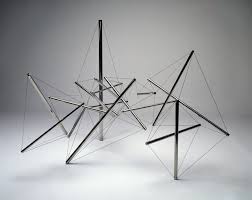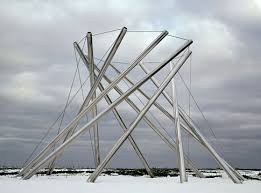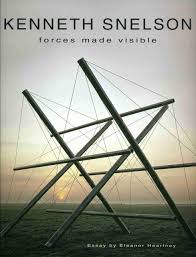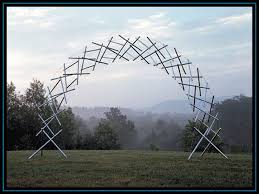KENNETH SNELSON – Flying High
KENNETH SNELSON – Flying High

Growing up in Pendelton, Oregon, Kenneth Snelson (1927-2016) loved to build model airplanes using balsa wood struts and Japanese paper. He liked the way the damp paper dried and drew tight around the balsa wood skeleton—the paper skin becoming drum-tight under tension, and the balsa wood struts gaining strength in compression. The interlocking of components through this balance of compressive and tensile forces resulted in an integrated structural composite that did not exist before assembly.
This experience of working with integrated and balanced structural forces stayed with Snelson through his school years. At night during 1945-46, he attended the Corcoran School of Art in Washington, DC. At the end of his sophomore year at the University of Oregon in 1948, after having taken some courses in architectural drawing and art, he thought he could become a painter. Eleanor Heartney, in her article “Forces Made Visible” writes of this period in Snelson’s life: “His most memorable teacher at the University was Jack Wilkinson, whose basic design course introduced him to the notion of art as an intellectual exercise, with discussions of semantics, Gestalt psychology, and mathematics. Wilkinson’s teaching methods drew on techniques from the educational program of the Bauhaus, the innovative industrial design school which operated in Germany from 1919 until it was shut down by the Nazis in 1933, its prominent practitioners fled to the United States. Bauhaus education was based on the notion that mass production was reconcilable with the individual artistic spirit and centered around workshops in which students learned the principles behind disciplines like metal, [and] wood sculpture…. In practice, as Snelson discovered, this involved practical exercises in the creation of objects out of cardboard, wire, balsa wood, paint and construction paper, activities that resonated with his childhood pursuits.”
Despite his longstanding interest in modelmaking, Snelson initially pursued painting, a field which in the late 1940s was dominated by debates over the meaning and direction of abstraction. Snelson was particularly enamored of figures like Josef Albers, Lionel Feininger, Wassily Kandinsky, and Paul Klee, all of whom might be called diagonalists if such a term had existed back then.
While in a library at the University of Oregon, Snelson read about Black Mountain College in North Carolina. When he discovered that Josef Albers, a former Bauhaus instructor, was dean of Black Mountain College, he and a friend decided to apply for admission to the summer session in 1948. (Albers’ involvement with Diagonality will be presented in a separate profile) Snelson spent two summers at Black Mountain College, which turned out to be pivotal in his career development. Although Snelson went to Black Mountain College to study painting, Albers sensed Snelson’s “feel” for object making and encouraged him in that direction. This shift of his interest to three-dimensional objects (which was more of a return to an earlier interest) was mainly due to his interaction with Richard Buckminster Fuller, which happened quite by chance. Josef Albers had recommended Fuller (1895-1983) for a summer faculty position as a last-minute replacement for Bertrand Goldberg, a Chicago architect, and a former Bauhaus student. Fuller was fifty-two years old at the time and regarded by many as a “delightful nut.” It was only later that Fuller’s true genius was recognized. Fuller was already calling his structural theory of balanced structural forces tensegrity. The word grew out of the ideas of tension and structural integrity.
Fuller’s Wichita House had been published in Fortune magazine in 1946, thus bringing some attention to his unorthodox approach to architecture. He arrived at Black Mountain with an aluminum trailer packed with his “magical world of mathematical models.” Some at the school had expected him to drive up in his Dymaxion car, a three-wheeled Buck-Rogers-looking vehicle. Initially, Snelson regarded Fuller as merely a “summer substitute for a legitimate architect.” Still, Snelson recalled that he was “absolutely hypnotized and electrified” when Fuller launched into a three-hour lecture that captivated his audience of students and teachers. Bucky’s talk dealt with his energetic and synergetic geometry based on the tetrahedron. Elaine de Kooning, who was an artist/teacher at Black Mountain College, remembered the iconoclast this way. “Bucky…whirled off into his talk, using bobby pins, clothespins, all sorts of units from the five-and-ten-cent store to make geometric mobile constructions, collapsing an ingeniously fashioned icosahedron by twisting it and doubling and tripling the modules down to a tetrahedron; talking about the obsolescence of the square, the cube, the numbers two and ten (throwing in a short history of ciphering and why it was punishable by death in the Dark Ages); extolling the numbers nine and three, the circle, the triangle, the tetrahedron, and the sphere; dazzling us with his complex theories of ecology, engineering, and technology. Then, he began making diagrams on a blackboard. He drew a square, connecting two comers with a diagonal line. “Ah,” he said affectionately, “here’s our old friend, the hypotenuse.” It might have been apparent to some at Black Mountain College that diagonality was alive and well.
When I write of Fuller’s lecture being captivating, I do so from a parallel experience. In the 1970s, I attended a three-hour evening lecture by Fuller in Philadelphia at what was then called La Salle College. Fuller, speaking without notes, was surrounded by an awed and smitten audience. A young architect myself at the time, having just opened my practice, I felt the heavens had opened before us as this “delightful nut” showered us with a new geometric vision of the cosmos, planet earth, and a novel approach to architectural structures. I was not into drugs, but it felt like I had just taken what I imagined to be a “trip” into a world of ideas that were not from this planet. A year or so earlier, I had experienced a Buckminster Fuller dome at Expo 67, an international exposition situated on an island near Montreal, Canada. Although the structure was a dome, the curved surfaces were composed of a myriad of hexagon-shaped “skylight” units, marrying a modular diagonal geometry with the spherical geometry of the mega-structure. The purity and modular nature of this vast interior space, replete with a monorail station within the sun-filled dome, reverberate within me to this day.
Bucky’s projects did not always meet with success. That first summer at Black Mountain, there was a plan to erect his first dome using multi-colored aluminum Venetian blind strips. The school had figured that such lightweight and inexpensive structures could solve their housing shortage. At the end of the summer, the architecture class gathered on a hill in the rain to witness the anticipated “miraculous event.” After being bolted together, the strips were expected to spring upright, something like a Jack in the box, but they were not strong enough to support themselves. Fuller had specified two layers of strips, but the school could only afford a single layer. Looking at the pile of “limp spaghetti,” Fuller explained that “you succeed when you stop failing.”
Black Mountain College was founded in 1933. It was an example of the progressive educational principles of John Dewey and the Bauhaus. The European tradition of Black Mountain College’s early years was replaced in 1948 with the thinking of young American artists and architects. Some future notables asked to teach there, but unable to attend were Marcel Breuer, I.M. Pei, and George Nakashima. Unlike other educational institutions, Black Mountain was faculty owned and operated, and devoted to the idea that the arts are central to any real education. The College operated in a radically democratic way; faculty and students participated in day-to-day operations like farm work, construction projects, and kitchen duty.
Snelson spent two summers at Black Mountain College in the years 1948 and 49. While Fuller was continuing to focus on “doing more with less,” Snelson said that for the first time, he was beginning to understand that structure was not just a matter of filling space with forms but “a result of forces which can form stable systems.”
Before returning for his second summer at Black Mountain, Snelson constructed a small stabile sculpture called Early X Piece. Two wooden, organically-shaped crosses were structurally connected only by nylon tension lines. One cross floated above the other, its position in plan view rotated 45 degrees from the cross below it. He mailed photographs of the model to Fuller and brought the sculpture with him when the summer course began. Recognizing the potential of the structure, Fuller asked Snelson to build a larger version in metal. A schism between Fuller and Snelson developed when Fuller took credit for Snelson’s discovery of discontinuous (not touching) compression members suspended in space and held in place by taught connecting wires or filaments in tension. Snelson is quoted as having said that Fuller “automatically assumes that because he is the hub of the wheel that anything that happens on the periphery is automatically his.” Fuller later coined the term tensegrity intended to describe tensile structures in which compression is discontinuous.
To earn a living, Snelson turned to cinematography for a while in the 1950s as he continued to experiment with his tensegrity sculptures. Finally, in the 1960s, he began to exhibit his work at the Dwan Gallery in New York City, and soon after that, the art scene caught on that here was a new and significant talent. The timing could not have been more propitious because minimal art was just then in its ascendancy.

Howard N. Fox, in a brochure accompanying Snelson’s one-man show at the Albright-Knox Art Gallery in Buffalo, New York in 1981 wrote, “The tension-compression principle was seen by some enthusiastic viewers as a valuable new approach to art [in 1960], because its inherent aesthetic rules had deep ramifications for contemporary sculpture. For some people, Snelson’s work may well have suggested the apotheosis of the constructivist tradition in modern art. …The resulting objects were z”hermetic,” referring to nothing outside themselves and depending on nothing external for their formal integrity. Moreover, they appeared to be indivisible structures that defined the very space they created and occupied.”

I don’t recall the year that I first saw a Snelson sculpture, but for me, it represented clear and striking evidence of the diagonal motif. I’m nearly certain that Snelson was not consciously motivated to create a work that would be identified as an expression of Diagonality. Why? Because no such phenomenon had been identified back then. The Phenomenon of Diagonality existed only in my just emerging and unpublished investigation into this motif. However, that is not to say that Diagonality as a design motif was not evident everywhere and may have subconsciously affected Snelson’s aesthetic predisposition. The diagonal was there to be seen in every country [if you could recognize it] in architecture, graphics, city planning, engineering structures, fashion, painting, and sculpture.

We now turn to Snelson’s works and see how they captured the sensibility of Diagonality raging through the art world at that time. (to be continued)
